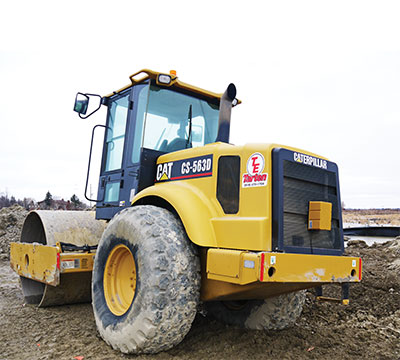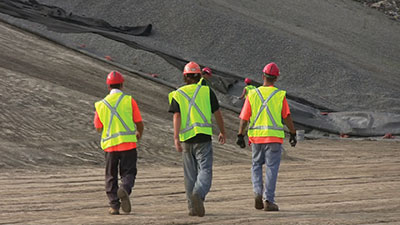
Armoured up
By Jonathan Fava Scan-Link Technologies
ProductsRadio Frequency Identification (RFID) safety clothing is apparel that is tagged with uniquely programmed passive RFID tags. RFID equipped vests are fitted with multiple RFID tags, discreetly sewn in behind 3M reflective tape.
Radio Frequency Identification (RFID) safety clothing is apparel that is tagged with uniquely programmed passive RFID tags. RFID equipped vests are fitted with multiple RFID tags, discreetly sewn in behind 3M reflective tape.
 |
|
| The vehicle senses the presence of the RFID clothing via an antenna mounted on its exterior. Mounting the RFID antenna is usually quite simple.
|
Different styled and sized vests come with either 14 or 15 Ultra High Frequency (UHF) passive tags. RFID equipped hard hats include 10 RFID tags affixed in a distributed pattern inside of any standard hard hat design. Each vest and hard hat is fitted with multiple passive RFID tags to increase the probability of detecting a worker’s presence, regardless of which direction the person may be facing. Each tag on the vest is programmed with a unique ID number allowing the system to identify the unique apparel serial number, the apparel type, and which of the forward and/or rear-facing tags were detected.
RFID safety systems, such as the Scan-Link Armour System, use a sensing antenna installed at the back of a vehicle as well as a display unit mounted in the cab. Workers are provided with RFID tagged hard hats and/or vests. If the sensing antenna detects an RFID tag within its detection range, it transmits detection information to the display unit, which in turn emits an audible sound and a visual prompt (flashes a row of red LED lights). The detection range may be adjusted anywhere from two meters to five meters depending on customer requirements. Multiple sensors can be mounted on equipment such as excavators where concerns about the swing radius need to be addressed. In this type of application, one antenna would be mounted on each back corner.
The antenna units can also be used in industrial and conveyer applications. Installing linear antennas alongside a conveyer belt can allow for the detection of a worker wearing the RFID tagged apparel. If the worker enters the sensing antenna detection zone, the system can trigger an alarm that can be used to initiate a shutdown sequence and mitigate a potential worker-machine interaction.
RFID technology was originally designed and built with the construction and waste industry in mind, but its application has moved into other industries such as oil and gas, mining, ports, steel manufacturing and many more. Any industry that operates equipment and has ground workers on site will benefit greatly from this technology. Most RFID technology is not industry-specific. It is designed for any company that cares for the safety of its people and wants to make a positive change.
The benefits for the end user are a reliable safety system that can detect people rather than objects. This means no false alarms; RFID clothing does not “cry wolf.” Any safety consultant will tell you this is an important consideration in any safety program. Systems and devices that generate frequent false alarms will quickly be ignored or disabled by workers or even management.
The larger pieces of equipment on most job sites are rugged and can handle a few knocks and bumps. Random objects on a job site can be replaced if struck by a machine, but not a human life. Company owners who rent machines equipped with RFID apparel will protect not only their ground workers but also contractors and visitors to the work site. All they need do is require all on-site personnel wear RFID-equipped safety vests and hard hats.
 |
|
| RFID safety gear could be a lucrative upsell opportunity with your heavy equipment customers, or a value-added giveaway to burnish your shop’s reputation for safety.
|
Ground workers who wear RFID-equipped safety vests and hard hats allow themselves to be detected, and allow operators to be alerted that there is a worker behind them – even if that worker is in the blind spot of the equipment. Equipment operators benefit from the elimination of false positive alarms that are common with active, vehicle-based obstacle detection systems. When the vehicle display alerts the operator of the presence of an RFID tag, they can be sure there is a ground worker behind their vehicle and not just a random object.
Our system, the Scan-Link Armour System, also has the capability to record data such as the date and time of detection, the specific apparel type and the tag ID that was detected. The data can be retrieved wirelessly using a laptop and the Scan-Link Rapid Pair software program. This data recording feature will help company owners and health and safety personnel gather valuable data that has not been available before. The number of potential near misses and possible fatalities that have been avoided can now be tracked and patterns where individuals are being regularly detected in danger zones can be recognized. Using such information will help owners and health and safety personnel identify the need to either retrain the worker or take another look at the job site layout.
Safety is part of every business today and has become both a culture and revenue-generating business opportunity. The concern for job site safety is ever growing and will not be going away. The use of RFID technology for personnel detection is an evolution in job-site safety which will soon be expected or mandated on worksites. Offering rental customers a safety system to protect ground workers takes that extra step away from the customer and provides an added-value service.
Preparing a rental fleet for this technology is as simple as installing a wire harness and a pre-fabricated bracket onto the equipment. The RFID antenna and display units are quick connecting so you can move the hardware to any piece of equipment as needed. The apparel is a consumable and an opportunity for another sales revenue stream.
About the author
Jonathan Fava is a founding partner in Scan-Link. Based in Ancaster, Ont., Scan-Link manufactures and distributes the Armour Safety System and backup safety products for mobile equipment. Scan-Link can provide custom, turnkey solutions for rental fleets.
Print this page
Leave a Reply